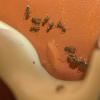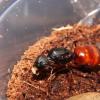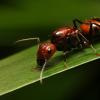Hi!
Some time ago I caught a very skinny Camponotus queen. Despite many numerous attempts to feed her honey, her gaster would never fill up. Does anyone have any tips for feeding her?
- Formiculture.com
- Forums
- Gallery
- Members
- Member Map
- Chat

Hi!
Some time ago I caught a very skinny Camponotus queen. Despite many numerous attempts to feed her honey, her gaster would never fill up. Does anyone have any tips for feeding her?
She is fully caulastral. She does not need to be fed. Put her in a test tube set-up and leave her alone. However, considering that her gaster is small she may be infertile.
Aphaenogaster cf. rudis
Tetramorium immigrans
Tapinoma sessile
Formica subsericea
Pheidole sp.
Camponotus nearcticus
Camponotus alates that fly later in the year are often malnourished and underfed. The only Camponotus queens that don't really need to be fed anything fly in the spring.
I know that Camponotus are claustral, I've already successfully reared four colonies.
Edited by Connectimyrmex, August 22 2017 - 11:59 AM.
Camponotus alates that fly later in the year are often malnourished and underfed. The only Camponotus queens that don't really need to be fed anything fly in the spring.
To my knowledge, there are no semi-claustral Camponotus species in Connecticut. Please correct me if I'm wrong.
Aphaenogaster cf. rudis
Tetramorium immigrans
Tapinoma sessile
Formica subsericea
Pheidole sp.
Camponotus nearcticus
I have to disagree in part about not needing to feed them. I have a few C. pennsylvanicus and C. chromaiodes queens who were late bloomers, with their brood not developing at fast as the rest. They seemed kind of lethargic and I didn't have high hopes for them. When I started feeding my other queens that did have workers, I decided to give them a drop of sugar water too. Not only did they voraciously drink it up, they also seemed much more lively after that. I know this is anecdotal, but I'm not sure there's an issue with giving them a little food even if they're fully claustural.
as long as they take it it's not an issue. BUT, they do not need to be fed. Although, they might accept it. But that doesn't make them semi-claustral.
Aphaenogaster cf. rudis
Tetramorium immigrans
Tapinoma sessile
Formica subsericea
Pheidole sp.
Camponotus nearcticus
Camponotus alates that fly later in the year are often malnourished and underfed. The only Camponotus queens that don't really need to be fed anything fly in the spring.
A colony doesn't generally produce alates unless conditions are optimal and food is plentiful. Not sure what evidence you used to come to this conclusion?
The leanness of the queen you caught could be explained many ways: she could have been evicted from her founding colony, she could be genetically or physically defective, or she could be a different species or hybrid with which you are unfamiliar, and possibly semi-claustral.
Thanks, guys. I kind of was confused there. I'll just wait and see if she recovers.
Yeah, it's probably just an abnormality - give her a few weeks and see how it's doing. If there's something really wrong with it genetically then there's a good chance that even if it does lay eggs, the workers could be weak/develop strangely too.
Proverbs 6:6-8 New International Version (NIV)
6 Go to the ant, you sluggard;
consider its ways and be wise!
7 It has no commander,
no overseer or ruler,
8 yet it stores its provisions in summer
and gathers its food at harvest.
I recall that alates have smaller abdomens and when they are fertile their gasters filled up with eggs and everything.
Aphaenogaster cf. rudis
Tetramorium immigrans
Tapinoma sessile
Formica subsericea
Pheidole sp.
Camponotus nearcticus
I released her. A few minutes after I released her, I actually found a fertile queen hiding under some wood scraps.
That's very lucky!
Aphaenogaster cf. rudis
Tetramorium immigrans
Tapinoma sessile
Formica subsericea
Pheidole sp.
Camponotus nearcticus
 |
Market Place →
General Market Place →
Asd’s Ant Shop! (CA) (not finished atm)Started by AsdinAnts , Yesterday, 8:40 PM |
|

|
|
 |
Market Place →
General Market Place →
Lf tetras and other spStarted by M14Mason , Apr 7 2024 |
|

|
|
 |
Ants & Myrmecology →
General →
Want to connect with antkeepers in ORStarted by Temno , Apr 7 2024 |
|

|
|
Anting →
General Anting →
Queen ant!Started by cooIboyJ , Mar 6 2024 |
|

|
||
Anting →
General Anting →
What ants should I expect at lake mead?Started by cooIboyJ , Mar 3 2024 |
|

|
0 members, 0 guests, 0 anonymous users